外研版(2019)选修一Unit 5 Revealing nature Developing ideas and Presenting ideas名师教学设计
文档属性
| 名称 | 外研版(2019)选修一Unit 5 Revealing nature Developing ideas and Presenting ideas名师教学设计 | 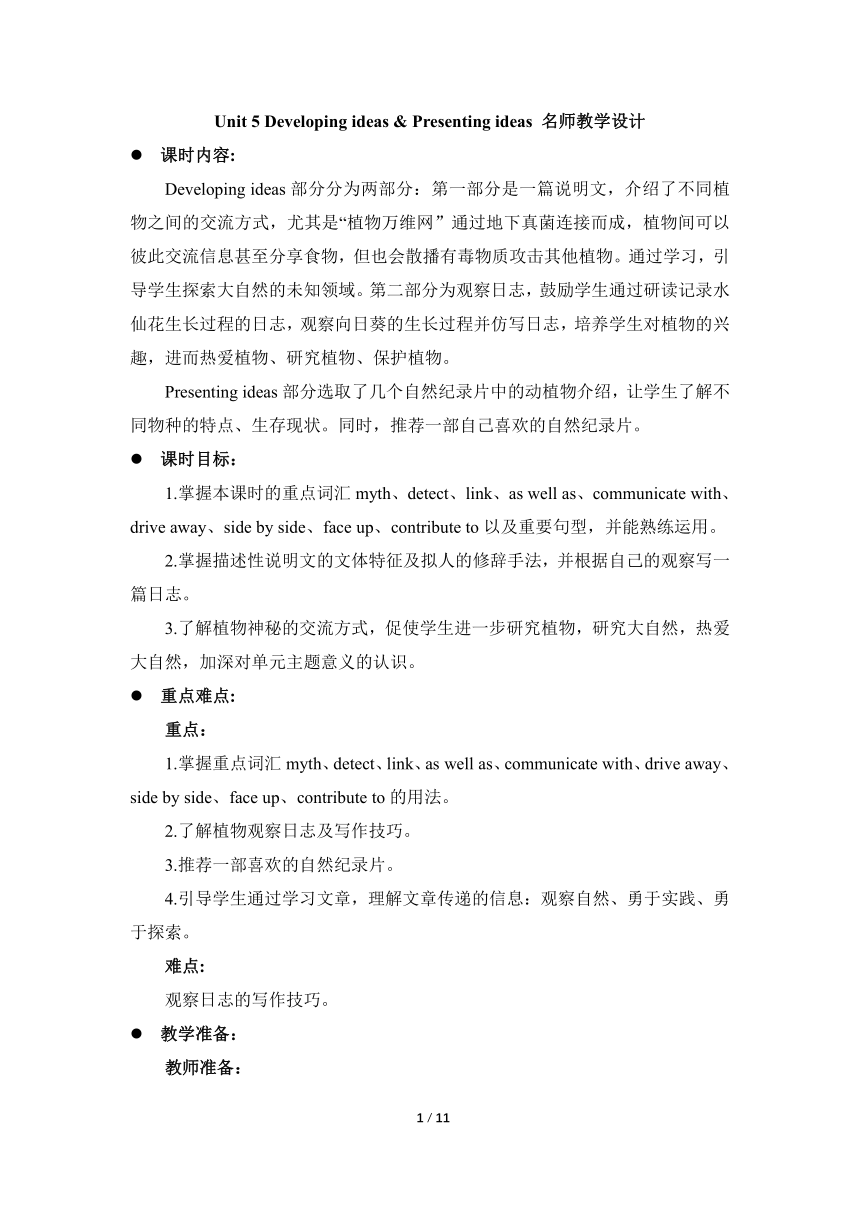 | |
| 格式 | docx | ||
| 文件大小 | 5.1MB | ||
| 资源类型 | 教案 | ||
| 版本资源 | 外研版(2019) | ||
| 科目 | 英语 | ||
| 更新时间 | 2023-03-02 20:47:02 | ||
图片预览

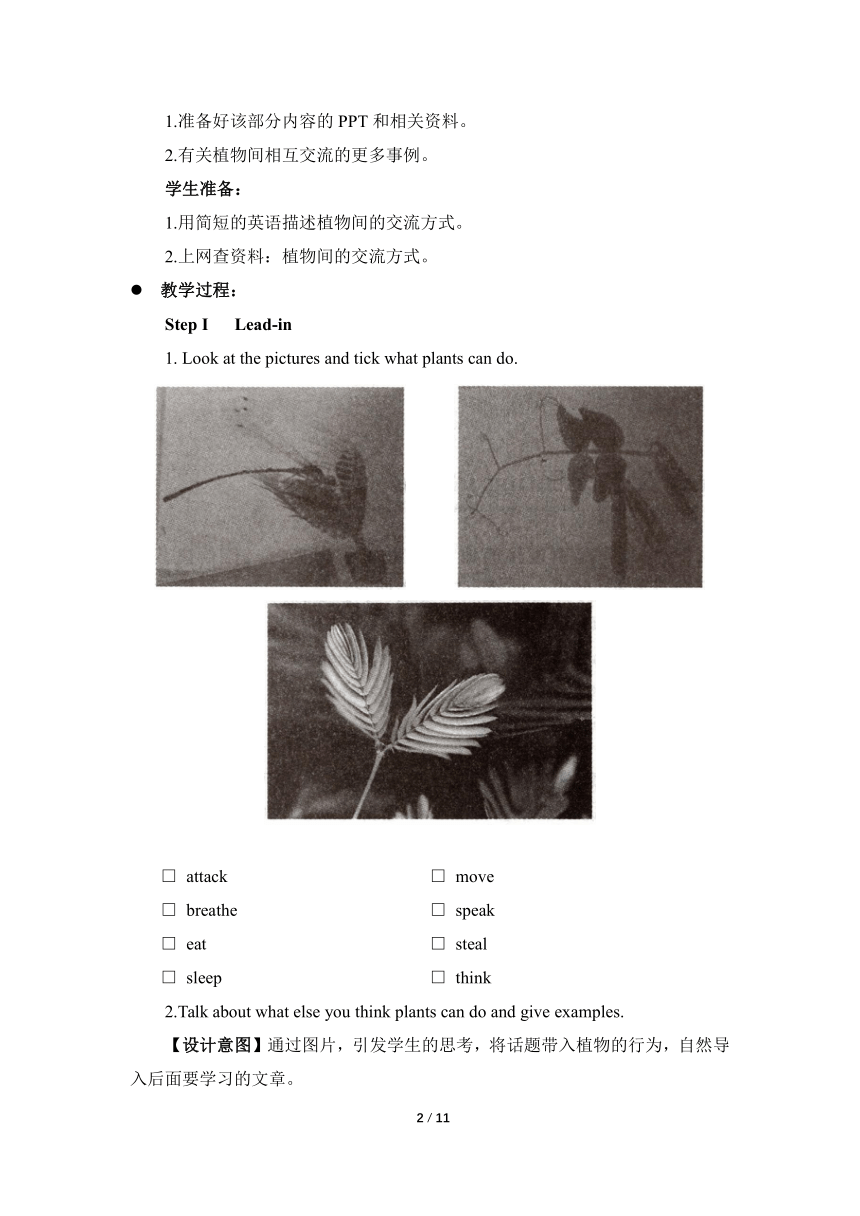
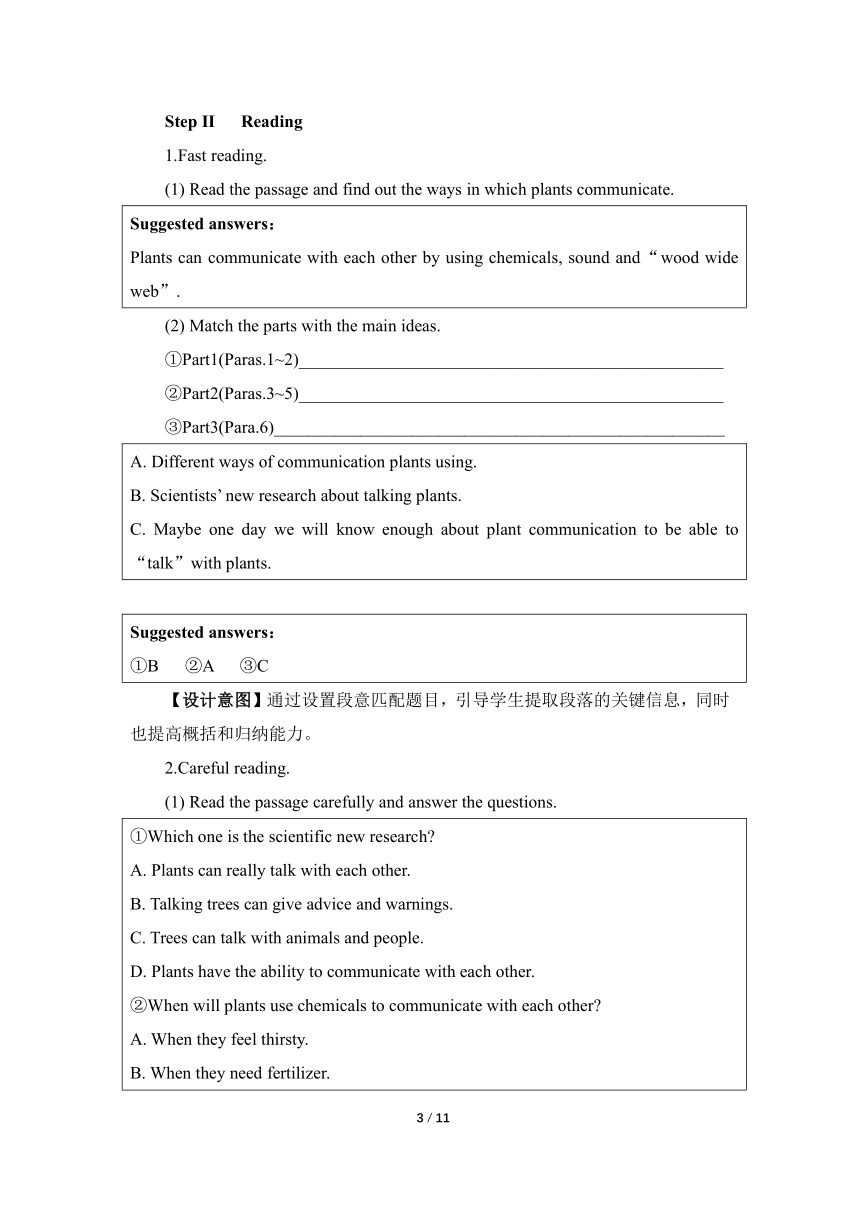
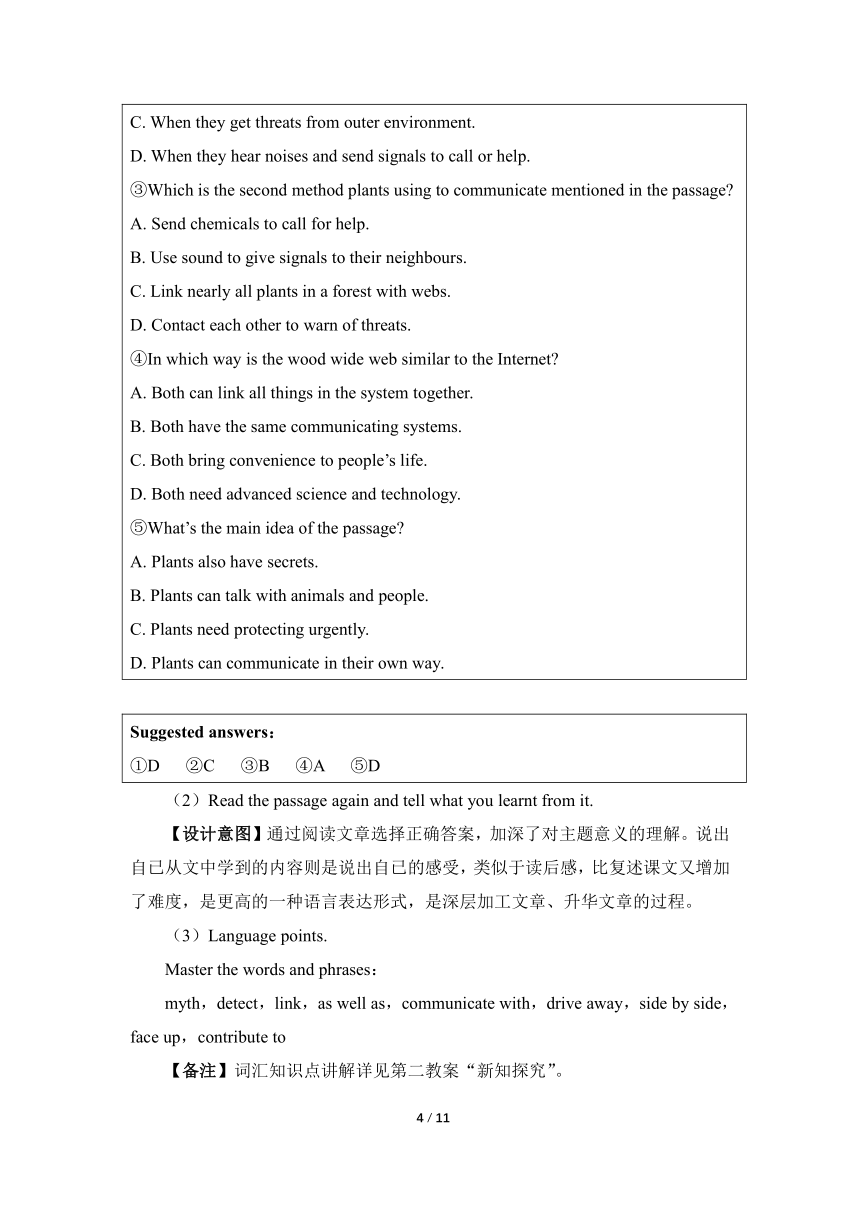
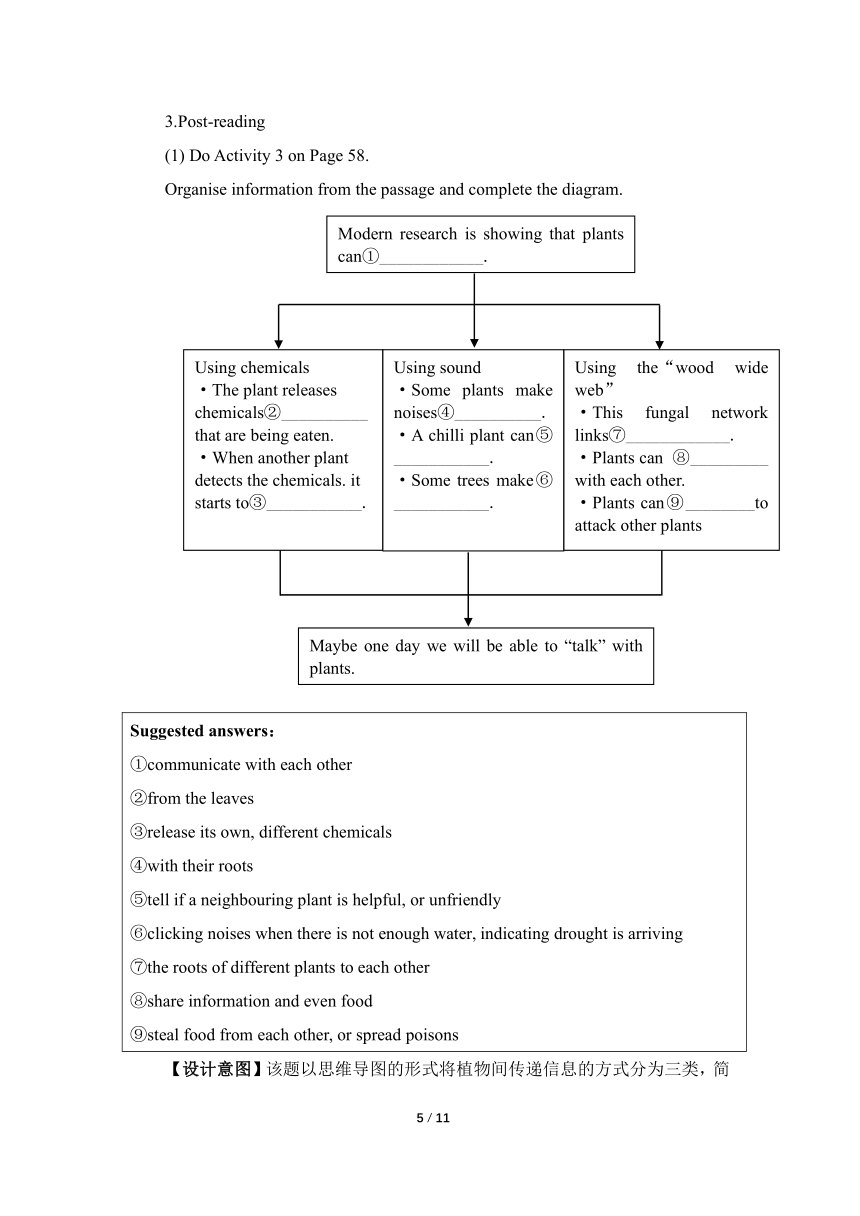
文档简介
Unit 5 Developing ideas & Presenting ideas 名师教学设计
课时内容:
Developing ideas部分分为两部分:第一部分是一篇说明文,介绍了不同植物之间的交流方式,尤其是“植物万维网”通过地下真菌连接而成,植物间可以彼此交流信息甚至分享食物,但也会散播有毒物质攻击其他植物。通过学习,引导学生探索大自然的未知领域。第二部分为观察日志,鼓励学生通过研读记录水仙花生长过程的日志,观察向日葵的生长过程并仿写日志,培养学生对植物的兴趣,进而热爱植物、研究植物、保护植物。
Presenting ideas部分选取了几个自然纪录片中的动植物介绍,让学生了解不同物种的特点、生存现状。同时,推荐一部自己喜欢的自然纪录片。
课时目标:
1.掌握本课时的重点词汇myth、detect、link、as well as、communicate with、drive away、side by side、face up、contribute to以及重要句型,并能熟练运用。
2.掌握描述性说明文的文体特征及拟人的修辞手法,并根据自己的观察写一篇日志。
3.了解植物神秘的交流方式,促使学生进一步研究植物,研究大自然,热爱大自然,加深对单元主题意义的认识。
重点难点:
重点:
1.掌握重点词汇myth、detect、link、as well as、communicate with、drive away、side by side、face up、contribute to的用法。
2.了解植物观察日志及写作技巧。
3.推荐一部喜欢的自然纪录片。
4.引导学生通过学习文章,理解文章传递的信息:观察自然、勇于实践、勇于探索。
难点:
观察日志的写作技巧。
教学准备:
教师准备:
1.准备好该部分内容的PPT和相关资料。
2.有关植物间相互交流的更多事例。
学生准备:
1.用简短的英语描述植物间的交流方式。
2.上网查资料:植物间的交流方式。
教学过程:
Step I Lead-in
1. Look at the pictures and tick what plants can do.
□ attack □ move
□ breathe □ speak
□ eat □ steal
□ sleep □ think
2.Talk about what else you think plants can do and give examples.
【设计意图】通过图片,引发学生的思考,将话题带入植物的行为,自然导入后面要学习的文章。
Step Ⅱ Reading
1.Fast reading.
(1) Read the passage and find out the ways in which plants communicate.
Suggested answers: Plants can communicate with each other by using chemicals, sound and“wood wide web”.
(2) Match the parts with the main ideas.
①Part1(Paras.1~2)_________________________________________________
②Part2(Paras.3~5)_________________________________________________
③Part3(Para.6)____________________________________________________
A. Different ways of communication plants using. B. Scientists’ new research about talking plants. C. Maybe one day we will know enough about plant communication to be able to “talk”with plants.
Suggested answers: ①B ②A ③C
【设计意图】通过设置段意匹配题目,引导学生提取段落的关键信息,同时也提高概括和归纳能力。
2.Careful reading.
(1) Read the passage carefully and answer the questions.
①Which one is the scientific new research A. Plants can really talk with each other. B. Talking trees can give advice and warnings. C. Trees can talk with animals and people. D. Plants have the ability to communicate with each other. ②When will plants use chemicals to communicate with each other A. When they feel thirsty. B. When they need fertilizer. C. When they get threats from outer environment. D. When they hear noises and send signals to call or help. ③Which is the second method plants using to communicate mentioned in the passage A. Send chemicals to call for help. B. Use sound to give signals to their neighbours. C. Link nearly all plants in a forest with webs. D. Contact each other to warn of threats. ④In which way is the wood wide web similar to the Internet A. Both can link all things in the system together. B. Both have the same communicating systems. C. Both bring convenience to people’s life. D. Both need advanced science and technology. ⑤What’s the main idea of the passage A. Plants also have secrets. B. Plants can talk with animals and people. C. Plants need protecting urgently. D. Plants can communicate in their own way.
Suggested answers: ①D ②C ③B ④A ⑤D
(2)Read the passage again and tell what you learnt from it.
【设计意图】通过阅读文章选择正确答案,加深了对主题意义的理解。说出自已从文中学到的内容则是说出自已的感受,类似于读后感,比复述课文又增加了难度,是更高的一种语言表达形式,是深层加工文章、升华文章的过程。
(3)Language points.
Master the words and phrases:
myth,detect,link,as well as,communicate with,drive away,side by side,face up,contribute to
【备注】词汇知识点讲解详见第二教案“新知探究”。
3.Post-reading
(1) Do Activity 3 on Page 58.
Organise information from the passage and complete the diagram.
Suggested answers: ①communicate with each other ②from the leaves ③release its own, different chemicals ④with their roots ⑤tell if a neighbouring plant is helpful, or unfriendly ⑥clicking noises when there is not enough water, indicating drought is arriving ⑦the roots of different plants to each other ⑧share information and even food ⑨steal food from each other, or spread poisons
【设计意图】该题以思维导图的形式将植物间传递信息的方式分为三类,简单明了,让学生根据关键词回扣原文,通过原文定位法找到答案,锻炼学生获取关键信息的能力
(2)Do Activity 4 on Page 58.
Before doing the activity,teacher explains personification to students.
Work in groups. Give a talk about communication between living things.
①Read the passage again and talk about how plants communicate. ②Think about and discuss the following ways of communication in the animal world. ·Bees“dance”to signal to other bees that they have found food. ·Ants communicate with each other through touch,chemical signals, moving their bodies and even using their legs to make sounds. What other ways can you think of ③Organise your ideas following the steps below. ·Begin with what living things you have chosen to talk about. ·Explain how they communicate and give examples. ·Conclude by explaining what we have learnt from their behaviour. ④Give a talk to the class about communication between living things.
【设计意图】通过拟人的手法让学生对植物之间的交流进行描述,有助于学生加深对主题的理解,进一步保护自然、爱护大自然。
Step Ⅲ Writing an observational journal
1. Do Activity 5 on Page 59.
Read the observational journal and answer the questions.
·How were the daffodil bulbs planted
·In what environment did the leaves grow
·What do the flowers look like
Suggested answers: ·They were planted side by side in soil, with the pointed ends facing up. ·The leaves grew in a sunny, but cool place. ·The flowers are yellow and white, and shaped like trumpets.
2. Do Activity 6 on Page 59.
(1) Work in pairs. Look at the pictures and talk about how the sunflower grows.
1 June 6 July 26 July
(2) Write your observational journal about the sunflower.
Suggested answers: An observational journal about the sunflower 1 June Covered with 1~2 cm of moist soil, the sunflower seed takes a few days to come up after being planted. Water has been added regularly and the hard seed coat softens in the damp soil to allow the first root to pierce downwards and the first leaves to push to the soil surface. 6 July The root continues to grow downwards. The single stem grows hollow and smooth, revealing large spade-shaped leaves from the growing tip. Gradually, the plant’s growing tip reveals the first hints of development of the flower bud. The plant stem becomes more woody. 26 July About three weeks after the flower bud first becomes visible at the tip of the sunflower stem, it enlarges and begins to reveal a flattened disc. Over the course of one week, the yellow ray florets, the disc florets bloom across the core of the sunflower blossom. It is yellow, looking beautiful.
3.Do Activity 7 on Page 59.
Work in pairs.Make improvements to each other’s observational journals and share them with the class.
【设计意图】该部分通过具体的观察日志的实例展示,教会学生观察日志的写作方法和包含要素,然后展示图片,让学生认真观察,并写出观察日志,达到学以致用的目的。
Step IV Presenting ideas
1. Work in groups. Look at the information about the nature documentaries and answer the questions.
life (2009,UK) Born in china (2016, China, US&UK)
The Private Life of Plants (1995,UK)
Big Cats (2018,UK)
·Can you guess what secrets of nature are revealed in these documentaries
·What other nature documentaries have you watched
Which one do you like most Give your reasons.
2. Choose one nature documentary you like and complete the notes.
Title:___________________________________________________________ Main theme:_____________________________________________________ Reasons you recommend it:________________________________________ ________________________________________________________________ ________________________________________________________________
3.Practise presenting information about your documentary. Consider the following:
(1)the structure of your presentation
(2)useful words,expressions and structures
4.Give your presentation to the class.
【设计意图】该部分通过观察图片,思考以前曾经看过的关于自然界的纪录片,并通过记述要点的形式记录自己喜欢的纪录片。根据提示,完成纪录片的要点描述,并向全班展示,进一步提高学生的书面表达能力和分享意识。
Step V Homework
Review the language points learnt in class.
板书设计:
Unit5 Revealing nature Period Ⅲ Developing ideas & Presenting ideas I. Lead-in 1. Look at the pictures and tick what plants can do. 2. Talk about what else you think plants can do and give examples. Ⅱ. Reading 1. Fast reading. 2. Careful reading. 3. Post-reading. Ⅲ. Writing an observational journal IV Presenting ideas V. Homework
2 / 2
课时内容:
Developing ideas部分分为两部分:第一部分是一篇说明文,介绍了不同植物之间的交流方式,尤其是“植物万维网”通过地下真菌连接而成,植物间可以彼此交流信息甚至分享食物,但也会散播有毒物质攻击其他植物。通过学习,引导学生探索大自然的未知领域。第二部分为观察日志,鼓励学生通过研读记录水仙花生长过程的日志,观察向日葵的生长过程并仿写日志,培养学生对植物的兴趣,进而热爱植物、研究植物、保护植物。
Presenting ideas部分选取了几个自然纪录片中的动植物介绍,让学生了解不同物种的特点、生存现状。同时,推荐一部自己喜欢的自然纪录片。
课时目标:
1.掌握本课时的重点词汇myth、detect、link、as well as、communicate with、drive away、side by side、face up、contribute to以及重要句型,并能熟练运用。
2.掌握描述性说明文的文体特征及拟人的修辞手法,并根据自己的观察写一篇日志。
3.了解植物神秘的交流方式,促使学生进一步研究植物,研究大自然,热爱大自然,加深对单元主题意义的认识。
重点难点:
重点:
1.掌握重点词汇myth、detect、link、as well as、communicate with、drive away、side by side、face up、contribute to的用法。
2.了解植物观察日志及写作技巧。
3.推荐一部喜欢的自然纪录片。
4.引导学生通过学习文章,理解文章传递的信息:观察自然、勇于实践、勇于探索。
难点:
观察日志的写作技巧。
教学准备:
教师准备:
1.准备好该部分内容的PPT和相关资料。
2.有关植物间相互交流的更多事例。
学生准备:
1.用简短的英语描述植物间的交流方式。
2.上网查资料:植物间的交流方式。
教学过程:
Step I Lead-in
1. Look at the pictures and tick what plants can do.
□ attack □ move
□ breathe □ speak
□ eat □ steal
□ sleep □ think
2.Talk about what else you think plants can do and give examples.
【设计意图】通过图片,引发学生的思考,将话题带入植物的行为,自然导入后面要学习的文章。
Step Ⅱ Reading
1.Fast reading.
(1) Read the passage and find out the ways in which plants communicate.
Suggested answers: Plants can communicate with each other by using chemicals, sound and“wood wide web”.
(2) Match the parts with the main ideas.
①Part1(Paras.1~2)_________________________________________________
②Part2(Paras.3~5)_________________________________________________
③Part3(Para.6)____________________________________________________
A. Different ways of communication plants using. B. Scientists’ new research about talking plants. C. Maybe one day we will know enough about plant communication to be able to “talk”with plants.
Suggested answers: ①B ②A ③C
【设计意图】通过设置段意匹配题目,引导学生提取段落的关键信息,同时也提高概括和归纳能力。
2.Careful reading.
(1) Read the passage carefully and answer the questions.
①Which one is the scientific new research A. Plants can really talk with each other. B. Talking trees can give advice and warnings. C. Trees can talk with animals and people. D. Plants have the ability to communicate with each other. ②When will plants use chemicals to communicate with each other A. When they feel thirsty. B. When they need fertilizer. C. When they get threats from outer environment. D. When they hear noises and send signals to call or help. ③Which is the second method plants using to communicate mentioned in the passage A. Send chemicals to call for help. B. Use sound to give signals to their neighbours. C. Link nearly all plants in a forest with webs. D. Contact each other to warn of threats. ④In which way is the wood wide web similar to the Internet A. Both can link all things in the system together. B. Both have the same communicating systems. C. Both bring convenience to people’s life. D. Both need advanced science and technology. ⑤What’s the main idea of the passage A. Plants also have secrets. B. Plants can talk with animals and people. C. Plants need protecting urgently. D. Plants can communicate in their own way.
Suggested answers: ①D ②C ③B ④A ⑤D
(2)Read the passage again and tell what you learnt from it.
【设计意图】通过阅读文章选择正确答案,加深了对主题意义的理解。说出自已从文中学到的内容则是说出自已的感受,类似于读后感,比复述课文又增加了难度,是更高的一种语言表达形式,是深层加工文章、升华文章的过程。
(3)Language points.
Master the words and phrases:
myth,detect,link,as well as,communicate with,drive away,side by side,face up,contribute to
【备注】词汇知识点讲解详见第二教案“新知探究”。
3.Post-reading
(1) Do Activity 3 on Page 58.
Organise information from the passage and complete the diagram.
Suggested answers: ①communicate with each other ②from the leaves ③release its own, different chemicals ④with their roots ⑤tell if a neighbouring plant is helpful, or unfriendly ⑥clicking noises when there is not enough water, indicating drought is arriving ⑦the roots of different plants to each other ⑧share information and even food ⑨steal food from each other, or spread poisons
【设计意图】该题以思维导图的形式将植物间传递信息的方式分为三类,简单明了,让学生根据关键词回扣原文,通过原文定位法找到答案,锻炼学生获取关键信息的能力
(2)Do Activity 4 on Page 58.
Before doing the activity,teacher explains personification to students.
Work in groups. Give a talk about communication between living things.
①Read the passage again and talk about how plants communicate. ②Think about and discuss the following ways of communication in the animal world. ·Bees“dance”to signal to other bees that they have found food. ·Ants communicate with each other through touch,chemical signals, moving their bodies and even using their legs to make sounds. What other ways can you think of ③Organise your ideas following the steps below. ·Begin with what living things you have chosen to talk about. ·Explain how they communicate and give examples. ·Conclude by explaining what we have learnt from their behaviour. ④Give a talk to the class about communication between living things.
【设计意图】通过拟人的手法让学生对植物之间的交流进行描述,有助于学生加深对主题的理解,进一步保护自然、爱护大自然。
Step Ⅲ Writing an observational journal
1. Do Activity 5 on Page 59.
Read the observational journal and answer the questions.
·How were the daffodil bulbs planted
·In what environment did the leaves grow
·What do the flowers look like
Suggested answers: ·They were planted side by side in soil, with the pointed ends facing up. ·The leaves grew in a sunny, but cool place. ·The flowers are yellow and white, and shaped like trumpets.
2. Do Activity 6 on Page 59.
(1) Work in pairs. Look at the pictures and talk about how the sunflower grows.
1 June 6 July 26 July
(2) Write your observational journal about the sunflower.
Suggested answers: An observational journal about the sunflower 1 June Covered with 1~2 cm of moist soil, the sunflower seed takes a few days to come up after being planted. Water has been added regularly and the hard seed coat softens in the damp soil to allow the first root to pierce downwards and the first leaves to push to the soil surface. 6 July The root continues to grow downwards. The single stem grows hollow and smooth, revealing large spade-shaped leaves from the growing tip. Gradually, the plant’s growing tip reveals the first hints of development of the flower bud. The plant stem becomes more woody. 26 July About three weeks after the flower bud first becomes visible at the tip of the sunflower stem, it enlarges and begins to reveal a flattened disc. Over the course of one week, the yellow ray florets, the disc florets bloom across the core of the sunflower blossom. It is yellow, looking beautiful.
3.Do Activity 7 on Page 59.
Work in pairs.Make improvements to each other’s observational journals and share them with the class.
【设计意图】该部分通过具体的观察日志的实例展示,教会学生观察日志的写作方法和包含要素,然后展示图片,让学生认真观察,并写出观察日志,达到学以致用的目的。
Step IV Presenting ideas
1. Work in groups. Look at the information about the nature documentaries and answer the questions.
life (2009,UK) Born in china (2016, China, US&UK)
The Private Life of Plants (1995,UK)
Big Cats (2018,UK)
·Can you guess what secrets of nature are revealed in these documentaries
·What other nature documentaries have you watched
Which one do you like most Give your reasons.
2. Choose one nature documentary you like and complete the notes.
Title:___________________________________________________________ Main theme:_____________________________________________________ Reasons you recommend it:________________________________________ ________________________________________________________________ ________________________________________________________________
3.Practise presenting information about your documentary. Consider the following:
(1)the structure of your presentation
(2)useful words,expressions and structures
4.Give your presentation to the class.
【设计意图】该部分通过观察图片,思考以前曾经看过的关于自然界的纪录片,并通过记述要点的形式记录自己喜欢的纪录片。根据提示,完成纪录片的要点描述,并向全班展示,进一步提高学生的书面表达能力和分享意识。
Step V Homework
Review the language points learnt in class.
板书设计:
Unit5 Revealing nature Period Ⅲ Developing ideas & Presenting ideas I. Lead-in 1. Look at the pictures and tick what plants can do. 2. Talk about what else you think plants can do and give examples. Ⅱ. Reading 1. Fast reading. 2. Careful reading. 3. Post-reading. Ⅲ. Writing an observational journal IV Presenting ideas V. Homework
2 / 2
